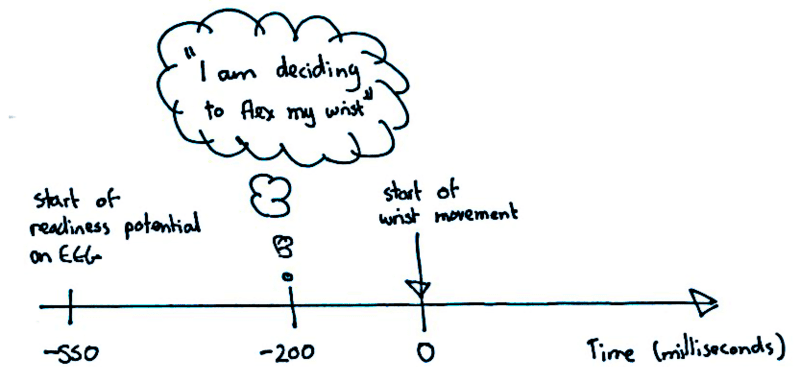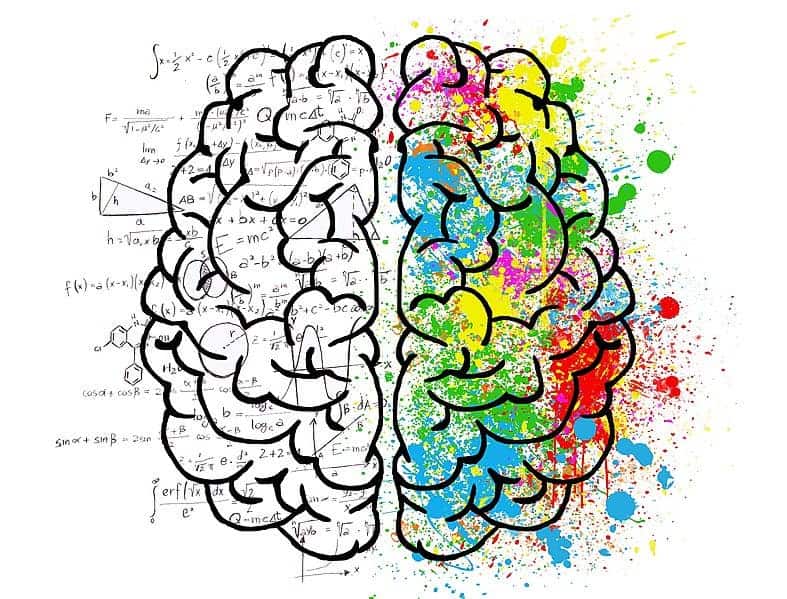
Does conscious will determine human behavior?
Many will undoubtedly find this question to be nonsensical, feeling that the answer is right in front of them. Willful actions, planned behaviors, achieved goals, all seem to provide unambiguous evidence for mental causation – for the idea that our conscious will determines our behaviors.
The widespread belief in mental causation has been enshrined into laws and ethics that depend on personal responsibility, which is typically seen as rooted in mental causation. While intuition, experience, and common sense firmly support mental causation, the role of conscious will in human behavior is far from established within scientific and philosophical circles. This matters, since if people are not consciously determining their behaviors, then we might need to revise our traditional understanding of human behavior and responsibility.
Let’s examine key findings from psychological and neuroscientific research into the relationship between conscious will and human behavior. While in no way exhaustive, the research covered here is valuable for informed discussions of conscious will, especially when considering the accuracy of our sense of mental causation. Hopefully, this will help shed new light on this fascinating topic.
Unconscious determinants of human behavior
In 1982, neuroscientist Benjamin Libet and his collaborators found that a type of brain activity, named readiness potential, consistently preceded research participants’ decisions to act. This finding was extended by later research showing that the readiness potential specifically precedes voluntarily initiated behaviors.
In Libet’s original study, participants sat in front of a large clock repeatedly measuring 2.56 seconds and were fitted with an EEG machine that measured their brains’ electrical signals. Participants were then asked to press a button at a time of their choosing, and notice the time at which they consciously decided to act. While this setup hardly resembles normal decision-making, participants still felt that their consciousness will caused their actions. Yet the timing of the readiness potential suggested that the brain prepared to act before the conscious experience of the decision to act, raising doubts on the veracity of participants’ sense of mental causation.
Libet’s study had serious methodological issues, and controversy soon followed. One issue was that very small differences (half a second on average) were observed between the times at which the decisions were reported, and the times at which the readiness potentials were recorded — meaning that measurement errors could have easily produced false results.
A second problem was that since only a single action was available to participants, the readiness potential might not have indicated the actual action, but rather indicated a general readiness to act. Given these flaws, Libet’s study could not conclusively establish that participants’ actions were unconsciously determined prior to their conscious decisions to act. But this wasn’t the end of the story.
In 2008, a study by neuroscientist John-Dylan Haynes and his collaborators addressed the issues of Libet’s study, and conclusively showed that action-specific brain activity preceded participants’ conscious decisions to act. This study improved on Libet’s design by allowing its participants to decide between two different behavioral options, and used more advanced methods to measure brain activity (fMRI), and the timing of conscious decisions. Consequently, the researchers managed to consistently predict an action’s nature 7 seconds before the reported timing of the decision to act, whereas its timing could be predicted 5 seconds before the decision. Such differences in timing could not be due to mere measurement errors. Furthermore, the researchers’ ability to predict the actions’ nature meant that the brain signals reflected more than just a general readiness to act.
Similar results were later found with consumer choices, and abstract decisions such as choosing a plan and deciding between mathematical operations. These findings show, as clearly as it gets, that seemingly mentally-caused behaviors are sometimes unconsciously determined prior to the conscious decision to act.

It should be noted that the current neuroscientific understanding of conscious will suggests that it too is related to brain regions that are involved in ‘vetoing’ unconsciously-formed actions or constraining them, rather than initiating actions. So it is not implausible that the conscious will influences behaviors by rejecting unconsciously prepared behaviors, rather than initiating behaviors on its own. This type of mental causation significantly differs from the intuitive sense of mental causation, and will not be further discussed.
Apparent mental causation
Neuroscientists revealed that behaviors are sometimes unconsciously determined prior to the conscious decision to enact them, meaning that mental causation is at least sometimes illusory. Nevertheless, the intuitive appeal of mental causation demands more generalizable evidence before it is conclusively refuted. Unless the neuroscientific findings are extended to personally meaningful behaviors, which often feel mentally caused, it is unlikely that many will be convinced to ignore their strong sense of mental causation. Our sense of mental causation is persuasive, but should we rely on it to differentiate between real mental causation and apparent mental causation?
Influential psychologist Daniel Wegner (1948-2013) and his collaborators theorized that people’s sense of mental causation of a behavior relies on three main principles:
- thoughts relevant to the behavior precede it (priority);
- the behavior must fit with the thoughts that preceded it (consistency);
- one’s conscious will should seem as the only plausible cause for the behavior (exclusivity).
Wegner argued that distinct yet related unconscious processes precede and are responsible for both thoughts and behaviors. Accordingly, since the processes determining behaviors also inform the processes which determine our thoughts, behavior-consistent thoughts often precede behavior, creating an illusory sense of mental causation. Based on these ideas, Wegner and his collaborators published their theory of apparent mental causation, and conducted elaborate studies to test its three principles. Their view of mental causation is depicted below.
Wegner’s principle of consistency received support from various studies. In one such study, participants put a ‘voodoo curse’ on a research assistant who later faked a headache. However, before casting the voodoo curse, some participants were made to dislike the research assistant.
Most participants generally felt somewhat responsible for the apparent decrease in the assistant’s health, but participants who were made to dislike the research assistant before putting the curse – whose thoughts were more consistent with their behaviors – felt greater responsibility for the assistant’s headache. In a different study, all participants were asked to perform menial activities, and some of them were asked to avoid thinking about what they were doing. As expected, participants whose thoughts were less consistent with their behaviors felt lesser responsibility for them and saw them as less voluntary.
The principle of consistency has been expanded by more recent research to involve more than just the conscious thoughts preceding the action. It also involves similarities between one’s outcome expectations – which can be unconscious – and a behavior’s actual outcomes. Furthermore, people’s sense of responsibility depends on the desirability of the outcomes, with greater responsibility felt for desirable outcomes, and lower responsibility for undesirable ones.
The principle of priority also received considerable support, as studies of consistency only work when thoughts are altered before the behavior. In a more direct study of priority, participants received movement instructions with which they could not comply, yet they perceived a visual illusion that made it seem as if they were moving according to the instructions. The results showed that behavior-consistent instructions given before the visual illusion made participants feel greater responsibility for the movements, although they knew that they did not physically move. In contrast, instructions presented after the behavior led to a sense of responsibility that was statistically indistinguishable from what was observed when no instructions were given. Thus, action-consistent information only increased participants’ sense of responsibility when presented before actions.

Exclusivity, the lack of plausible alternatives to mental causation, is arguably the most decisive principle behind our sense of mental causation.
This is illustrated by “split-brain” patients who undergo a surgical procedure where the connections between the two hemispheres of their brains were severed. This procedure meant that information processed only by the right hemisphere (which processes the left visual field) could not be verbally described, since verbal communication and interpretation require the left hemisphere (which processes the right visual field) to be involved. This is why the left hemisphere is known as the brain’s ‘interpreter’, which creates conscious verbal explanations and narratives that make sense of people’s experiences. However, the material presented to the right hemisphere can still be responded to non-verbally, using paintings and hand gestures.
To study split-brain patients, researchers made behavioral requests that could only be perceived by the patients’ nonverbal side, and after the requested behaviors were performed, the patients were asked to verbally explain why they performed these behaviors. To answer, they needed to use the brain’s ‘interpreter’ side, which was unaware of the original request.
Yet instead of reporting that they did not know the reasons for their behaviors, patients new to the split-brain condition often came up with posthoc explanations that made it seem as if they consciously willed their nonverbal side’s behaviors. They tried to justify this somehow.
This was uniquely striking. In one example, researchers showed the word ‘smile’ to a patient’s nonverbal side, and ‘face’ to the verbal side. They then asked the patient to draw what he saw, and so he drew a smiling face using the hand corresponding to his brain’s nonverbal side. When asked why he painted a smiling face, the patient replied with “What do you want, a sad face? Who wants a sad face around?”.
While there are studies that more carefully document how changes in exclusivity lead to changes in perceptions of mental causation, I find split-brain cases to be particularly compelling. They illustrate that even when prior action-consistent thoughts are absent, people can still feel mentally responsible for their behaviors as long as they don’t have a plausible external (to one’s body) competing cause. It took repeated exposure to extraordinary evidence against mental causation until split-brain patients realized that they did not know the reason for their nonverbal side’s behavior. Suggesting that absent plausible external causes, exclusivity is strongly biased in favor of mental causation, as opposed to causation by unconscious brain processes.
Taken together, the principles by which we detect mental causation imply that if apparent mental causation is real, then we will struggle to accurately distinguish between true and apparent mental causation.
Priority and consistency are satisfied under both situations, and thus cannot be trusted to distinguish them. Nor can the principle of exclusivity help. Split-brain cases revealed a strong bias towards mental causation being the only plausible internal cause for voluntary behaviors, which was overcome by repeated exposure to extraordinarily strong evidence to the contrary. Worse still, when relying on exclusivity to estimate mental causation, we can find ourselves falling into a self-reinforcing loop of circular reasoning: we experience mental causation because our conscious will seems like the most plausible internal cause of our behaviors, and we feel that the conscious will is the most plausible internal cause because we experience mental causation.
Integrating the findings
Taken together, the psychological and neuroscientific research calls the validity of the intuitive appeal of mental causation into question. The neuroscientific research clearly shows that apparent mental causation sometimes takes place. Whereas psychological research convincingly shows that our sense of mental causation cannot be trusted to distinguish between true and apparent mental causation. We experience mental causation when there aren’t plausible external causes for our behaviors because we do not realize the extent to which unconscious processes determine our behaviors.
If we cannot trust our experiences of mental causation, then what evidence remains in favor of mental causation? We seem to be mostly left with what I call ‘arguments from wishful thinking’, such as that mental causation should be seen as true because its rejection would challenge our moral systems, and might lead to negative personal consequences. I hold that we should come to terms with the human condition, and try to make the best of it. We don’t have good reasons to believe that mental causation is common, and there are serious issues surrounding its consistency with modern physics. Not to mention that, unlike apparent mental causation, actual mental causation was never scientifically demonstrated. To paraphrase Sigmund Freud: conscious awareness “is not even master in its own house, but must content itself with scanty information of what is going on unconsciously” – a view that fits with much with modern psychology.
That is not to say that the contents of consciousness have no implications for behavior, or that the mind doesn’t matter. Action-consistent thoughts often precede behaviors, making thoughts relevant for understanding human behaviors. Furthermore, there are no serious scientific doubts that our intentions can predict future behaviors, and that our beliefs can help explain our behaviors. Our thoughts matter, our beliefs matter, and our intentions matter. They make conscious will fairly useful as an explanation for human behaviors. Yet mental causation might be no more than apparent.
This is a guest essay from Benny Markovitch, ZME Science contributor. The views presented here belogn to the author.
Author’s note to the reader:
Thanks for reading! I know the topic can be quite challenging, and seeing is believing, so here is a video about a split-brain patient, and here is a video about behavior-prediction using fMRI.


